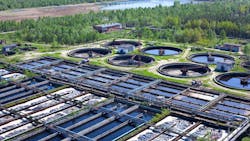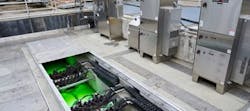Throughout the past several decades, increased awareness of the potentially undesirable impacts of chemical wastewater treatment has prompted a shift toward alternatives like ultraviolet (UV) treatment. UV treatment offers a range of cost-saving and operational benefits, driving its adoption in municipal wastewater facilities.
Regulations limiting residual chlorine have accelerated the development of UV treatment systems, which have been widely adopted since the first U.S. installation in 1982. Today, roughly 50% of wastewater in North America is treated using UV technology. UV light provides rapid and effective inactivation of microorganisms without adding harmful by-products to the water or altering its chemical composition.
Here are six reasons why wastewater treatment plants are increasingly turning to UV:
1. Footprint and Contact Time
Chlorine treatment systems require sizable contact chambers to ensure sufficient contact time—typically around 30 minutes—for chlorine to inactivate microorganisms in wastewater. On the other hand, UV treatment has a significantly shorter contact time, often measured in seconds or fractions of a second. Since the retention time for UV is measured in seconds or fractions of a second, a typical wastewater treatment plant may reclaim space after converting to UV. This can result in substantial space savings for wastewater treatment plants that use UV technology.
Modern UV systems, like the TrojanUVSigna®, have made retrofitting existing chlorine contact tanks much easier. In many cases, these retrofits do not require major modifications to the channel depth or width, as UV systems do not depend on stringent tolerances for concrete walls. This simplifies the upgrade process, making it both cost-effective and efficient. For example, a TrojanUVSigna® installation, shown in the above image, can treat up to 20 MGD (875 l/s) within a footprint of just 250 square feet (23 m²), a significant space-saving benefit.
2. Cost Advantages
Municipalities and wastewater treatment plants often work with engineering firms to compare water treatment alternatives, weighing both capital and operational expenses. This analysis becomes especially relevant when constructing new treatment plants or upgrading existing ones to meet regulatory requirements.
Capital Expense: Capital expenses for water treatment systems include the initial cost of equipment installation or the upgrade of existing facilities. These costs are relatively straightforward to quantify and typically include expenditures for contract management, design engineering, land acquisition, and the purchase and installation of equipment. The capital expense for a chlorine-based treatment system often involves complex infrastructure like chemical storage tanks, large contact basins, and safety provisions for chemical handling. Alternately, UV systems can be more cost-effective in terms of initial installation, particularly when retrofitting an existing facility due to their compact design and fewer safety requirements. Additionally, UV systems can often fit into existing chlorine contact chambers, eliminating the need for extensive civil work.
Operating Expense: The ongoing operating costs of water treatment systems can vary based on several factors. For chlorine systems, costs include the supply and transportation of chemicals (chlorine gas or sodium hypochlorite), labor, training, certification, emergency response planning, and regular safety audits. Emergency planning for chemical leaks and safety protocols adds to the administrative burden and long- term operating costs. UV systems, on the other hand, tend to have lower operational expenses because they do not require chemical handling protocols. The primary costs associated with UV systems are electricity consumption and the periodic replacement of UV lamps.
Electricity is a key component of UV system operation, as UV lamps require power to generate the UV light necessary for treatment. However, modern UV systems are energy-efficient, and many have power-saving features such as automatic lamp dimming based on real-time flow conditions. Replacement lamps are another operational cost, but with long-lasting amalgam that provide stable UV output over extended periods (up to 18,000 hours for TrojanUV Solo Lamps®), these costs are infrequent and predictable.
Overall, while the capital expenses for both chlorine and UV systems may be similar, the operating expenses of chlorine systems are generally higher due to the ongoing need for chemicals, safe handling protocols, and complex operations. UV systems offer a simpler, more cost-effective solution in the long term.
3. Transportation and Operation
Handling chlorine for wastewater treatment involves extensive safety precautions due to its hazardous properties. Chlorine gas is transported in large cylinders and requires specialized containment, storage, and safety protocols. Sodium hypochlorite, a liquid form of chlorine, is also hazardous and requires similar handling and storage considerations to prevent leaks and spills.
Incidents involving chlorine can lead to costly evacuations, system shutdowns, or other consequences, making chemical handling an operational risk. Alternately, UV systems are simpler to operate and maintain. They do not require the direct handling of hazardous chemicals, thus eliminating the need for certifications and emergency preparedness for chemical exposure. Routine maintenance for UV systems typically involves tasks such as changing out UV lamps, cleaning the quartz sleeves (many systems now feature automatic sleeve cleaning), and performing system checks.
4. By-Products
Wastewater contains numerous organic and inorganic substances. Chlorine-based water treatment often leads to the formation of harmful disinfection by-products (DBPs) when chlorine reacts with organic matter in the water. These DBPs, including trihalomethanes (THMs) and haloacetic acids (HAAs), have been rigorously studied and are known to be detrimental to the environment. Managing DBP formation can add complexity and cost to chlorine-based treatment systems.
UV treatment offers a significant advantage in this regard because it is a purely physical process. UV light inactivates microorganisms without altering the chemical composition of the water, meaning no harmful by- products are formed during the process.
Regulations accelerated the development and adoption of UV for municipal wastewater treatment and in 1986, the USEPA Design Manual Municipal Wastewater Disinfection was published. It included comprehensive pilot data on UV systems and design guidelines for this rapidly growing technology.
5. Dechlorination
Regulators have imposed increasingly stringent limits on the levels of residual chlorine allowed in effluent discharged into receiving waters. For some wastewater treatment plants, this has necessitated an additional process—dechlorination—to remove residual chlorine from the effluent before it is released into the environment.
The dechlorination process typically involves the use of a reducing chemical, such as sodium bisulfite (NaHSO₃) or sulfur dioxide (SO₂). Both chemicals require special provisions for handling, storage, and emergency response training. In recent years, sodium bisulfite has become increasingly favored over sulfur dioxide due to its safer handling profile.
During the final stage of chlorine-based wastewater treatment, sodium bisulfite is often dosed into the wastewater within a dechlorination basin. To effectively neutralize residual chlorine, the reducing agent must be thoroughly mixed with the effluent and provided sufficient contact time to ensure the chlorine is properly removed.
Precise dosing and control of the reducing agent are critical to achieving the desired outcome. Overdosing can result in the formation of sulfites, lower the dissolved oxygen (DO) content, and decrease the pH of the effluent. If oxygen levels are excessively depleted, the water may need to be re-aerated before discharge, adding extra energy and cost. Regulatory permits often set limits on dissolved oxygen concentration, as low DO levels in receiving waters can harm aquatic and plant life.
Alternately, UV treatment doesn’t require any downstream removal of residual chemicals.
6. Carbon Footprint
UV treatment of wastewater has a lower carbon footprint when compared to other types of wastewater treatment. The carbon footprint of UV technology primarily comes from the electricity required for operation. It’s also important to note that the UV carbon footprint is particularly low in regions where electricity grids are made of carbon-less sources (e.g. Ontario, Canada).
UV systems can also reduce power requirements of operation more readily, lowering the carbon footprint of operation. Additionally, new technologies like solo lamps are reducing lamp count and frequency of lamp replacement, further reducing the carbon footprint of quartz manufacture in older styles of lamps.
As carbon-friendly energy sources (wind, hydro, solar, nuclear) of power become more frequently used, the embedded carbon footprint of UV will continue to drop. However, chemical-based water treatment will be less influenced by the use of renewable energy because truck transportation will continue to be driven by the burning of fossil fuels for quite some time.
TO DOWNLOAD A PDF COPY OF THIS ARTICLE, PLEASE CLICK HERE TO BE REDIRECTED TO A PAGE WHERE YOU CAN DIRECTLY DOWNLOAD THE EBOOK


